What Type of Saddle
Do You Need?
People come in various shapes and sizes and so do saddles. It's not
surprising then, that not every saddle fits every rider. When the horse is
added to the equation, finding the right saddle can make you wish you'd
taken up tennis! I've spent a good deal of time in the last dozen or so
years helping riders select the saddle that best suits them and their horse
and have learned a lot in the process. Perhaps my experience can prevent you
from making a very expensive mistake.
Balance
 Any
saddle must meet one very basic criteria in order to function as a useful
tool for riding: it must be correctly balanced. This is especially true of
the dressage saddle, owing to the refinement of weight and leg aids. This
first drawing is an illustration we're all familiar with. In order to allow
the rider to sit in a balanced position; with half of the upper body mass on
either side of the vertical line bisecting shoulder, hip and heel; the
stirrup bar of the saddle must be correctly placed. The stirrup leathers
should hang vertically and approximately 6" or 7" forward of the deepest
part of the seat. This corresponds roughly to the measurement from the ball
of the foot to the heel. The relationship of these two measurements is
obvious. If the deepest part of the saddle falls more than about 7" back
from the stirrup bar, the rider is encouraged to carry his leg too far
forward and automatically adopts the chair seat. Conversely, a stirrup bar
placed too far rearward causes the rider to sit on the crotch. We'll talk
more about balance when we discuss fitting the horse.
Any
saddle must meet one very basic criteria in order to function as a useful
tool for riding: it must be correctly balanced. This is especially true of
the dressage saddle, owing to the refinement of weight and leg aids. This
first drawing is an illustration we're all familiar with. In order to allow
the rider to sit in a balanced position; with half of the upper body mass on
either side of the vertical line bisecting shoulder, hip and heel; the
stirrup bar of the saddle must be correctly placed. The stirrup leathers
should hang vertically and approximately 6" or 7" forward of the deepest
part of the seat. This corresponds roughly to the measurement from the ball
of the foot to the heel. The relationship of these two measurements is
obvious. If the deepest part of the saddle falls more than about 7" back
from the stirrup bar, the rider is encouraged to carry his leg too far
forward and automatically adopts the chair seat. Conversely, a stirrup bar
placed too far rearward causes the rider to sit on the crotch. We'll talk
more about balance when we discuss fitting the horse.
Twist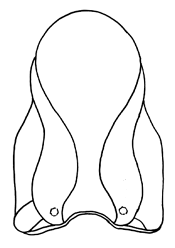
The twist of the saddle, viewed from above, is the narrowest portion of
the seat, located just behind the pommel. Saddles can be broadly categorized
into narrow twist and broad twist, with great variation possible within each
category. The general type of twist you need depends upon the conformation
of your pelvis and the way the femur is attached to it as well as the shape
of the inner thigh muscle.
Let's begin by separating the boys from the girls. Figure 3 illustrates
the basic skeletal differences between men and women with regard to the
shape of the pelvis. As you can see, women's seat bones tend to be further
apart than those of men. This can cause a problem if the twist of the saddle
is too narrow. In such a case, the seat bones are not correctly positioned
on top of the saddle but fit down around the saddle - a very uncomfortable
position! However this is a very rare situation since the seatbones do not
sit on the saddle close to the pommel, but considerably further back, where
the saddle begins to broaden. In fact, the crotch pain that many riders,
especially women, experience rarely has anything to do with the width
between the seatbones. Instead it has everything to do with the positioning
of the femur in relation to the pelvis and the shape of the muscle of the
inner thigh. 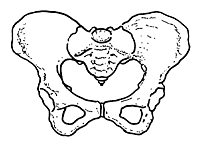
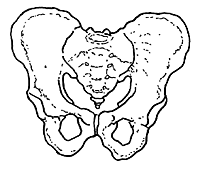
Figure 3
Left: Female
Right: Male
 The shafts of the two femurs are separated by the
diameter of the pelvis and the shafts slope downward and inward to bring the
knee joints near the line of gravity of the body. Owing to the female
pelvis' being shallower and wider than that of men, this inward slope tends
to be greater in women (left illustration) than it is in men (right
illustration) though there is considerable variation between individuals.
The more knock-kneed an individual is the more the inner thigh muscle tends
to be relatively round. The more nearly perpendicular the shafts of the
pelvis hang, the flatter the inner thigh muscle (the reason that most men
have much flatter inner thigh muscles than women and thus much less
difficulty getting the thigh to lie flat against the saddle).
The shafts of the two femurs are separated by the
diameter of the pelvis and the shafts slope downward and inward to bring the
knee joints near the line of gravity of the body. Owing to the female
pelvis' being shallower and wider than that of men, this inward slope tends
to be greater in women (left illustration) than it is in men (right
illustration) though there is considerable variation between individuals.
The more knock-kneed an individual is the more the inner thigh muscle tends
to be relatively round. The more nearly perpendicular the shafts of the
pelvis hang, the flatter the inner thigh muscle (the reason that most men
have much flatter inner thigh muscles than women and thus much less
difficulty getting the thigh to lie flat against the saddle).
What has all this to do with crotch pain, you ask?
Everything.........
When the rider sits correctly in the saddle he (or she) will be supported
by his seatbones, the pubic crest (crotch) and the muscles of the inner
thigh. The two generalized saddle shapes are illustrated in Figure 5. The
left illustration corresponds to a broad twist saddle and the right to one
with a narrow twist. The narrower the twist, the more the saddle tends to be
concave on either side of the pommel. The concavity of narrow twist saddle
very nicely accommodates the greater mass of a rounded thigh muscle and
allows the rider to receive the proper amount of support from the thigh. A
flat thigh muscle would not provide the rider of saddle Figure
5-right with any measurable amount of support until several inches down
from either side of the pommel. This would result in such a rider bearing
too much weight on the pubic crest and would result in much discomfort. The
broader twist illustrated in Figure 5-left would support the flat
inner thigh very nicely and would correctly and comfortably distribute the
rider's weight.
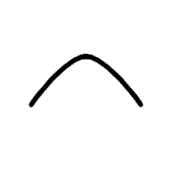
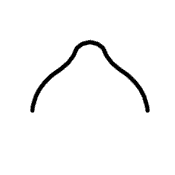
Figure 5
Left = wide twist
Right = narrow twist
While men tend to have the flatter inner thigh muscles associated with
the need for a broader twist, because of the narrower pelvis, there is
usually less distance between the shafts of the femur and thus few men will
be comfortable riding a really broad twist saddle but will tend to prefer
something with a more moderate twist.
How can you be sure the saddle fits the horse?
Balance
While there are many subtleties of saddle fit you can always be sure
you’re on the right track when the previously mentioned balance is present.
Different brands and models of saddles may look quite different from each
other when correctly fitted. Consequently, if you try to fit all saddles by
applying certain rules that you've doubtless read in the myriads of saddle
fit articles published in recent years, such as, cantle should be X inches
higher than the pommel or, you should have X fingers’ clearance at the
pommel - it becomes very confusing. Some saddles are designed to fit with
the cantle substantially higher than the pommel (2" or even more) while
others are designed to be nearly level, front to back. No saddle is designed
to sit lower in the cantle than the pommel, however, horses with a low back
conformation will sometimes be correctly fitted when the cantle does indeed
sit lower than the pommel. These horses are always a challenge to ride for
they can rarely be fitted with a gusset type panel and artificially raising
the cantle with a "bump" pad or other device may result in a badly damaged
saddle tree and is most always uncomfortable for the horse.
First things first - you must ascertain exactly where on the
horse's body the saddle should sit. Horses having a lot of Thoroughbred
blood are rarely difficult to decide where the saddle should sit - they have
a pronounced indentation right behind the shoulder blade and if you try to
place the saddle anywhere else it will quickly find its way to this "sweet
spot." Unfortunately, many Warmbloods as well as other breeds such as
Arabians and Morgans, frequently lack this clearly defined area. The saddle
should be placed immediately behind the horse's scapula - not on top
of it. To determine where the scapula is located, have someone lead your
horse for you while you walk beside him with your hand on the shoulder
blade. As he moves it will rotate about its axis and allow you to visualize
its location. Place your saddle just behind the scapula and girth it
sufficiently to hold it securely in place.
Keeping the rule of balance uppermost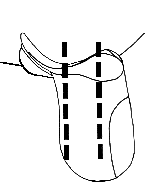 in your mind, stand to the side of your horse and draw an imaginary line
through the center of the stirrup bar, perpendicular to the ground. Draw a
second imaginary line through the deepest part of the seat, again
perpendicular to the ground. As mentioned before, the deepest part of the
seat should be approximately 6-7" back from the center of the stirrup bar.
in your mind, stand to the side of your horse and draw an imaginary line
through the center of the stirrup bar, perpendicular to the ground. Draw a
second imaginary line through the deepest part of the seat, again
perpendicular to the ground. As mentioned before, the deepest part of the
seat should be approximately 6-7" back from the center of the stirrup bar.
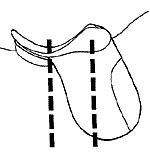 The illustration at left shows a saddle that is too narrow for
the horse and consequently sits with the deepest part of the seat too far
back from the stirrup bar. The last illustration of this series shows a
saddle that is too wide and has the deepest part of the seat too close to
the stirrup bar. The former will place your legs too far to the front while
the latter will tend to tip you onto your crotch.
The illustration at left shows a saddle that is too narrow for
the horse and consequently sits with the deepest part of the seat too far
back from the stirrup bar. The last illustration of this series shows a
saddle that is too wide and has the deepest part of the seat too close to
the stirrup bar. The former will place your legs too far to the front while
the latter will tend to tip you onto your crotch.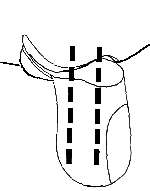
Width
Once you've ascertained that the balance is correct, check the width of
the tree by stepping to the front of the saddle and observing the fit along
the horse's barrel. The "welt" of the saddle (the round piece of leather
that runs across the pommel and down either side) will usually correspond
fairly accurately to the shape of the tree of the saddle. If you lay a
riding whip along the horse's body, starting at the top of his withers and
right in front of the saddle, you can compare the actual angle of his body
to that of the tree of the saddle. If the two angles are very nearly
identical, the width is correct. If the two lines converge over the top of
the horse's back, the saddle is too wide, while it's too narrow if the lines
diverge. A word of caution here: It is the lesser evil if the saddle is
slightly (and I do mean slightly) too narrow than if it is slightly
too wide. A very mildly narrow saddle is an inconvenience to the rider
because it will tend to cause his balance to be a bit too far back but
nonetheless results in an even pressure along the panels of the saddle and
no discomfort to the horse. A slightly wide saddle will increase the
pressure in the area of the bars of the tree and result in discomfort on the
part of the horse, who will usually react by tightening his shoulders and
shortening the reach of the forelegs.
Bridging
"Bridging" is the result of a panel that is not contoured to
fit the shape of the horse's back. It has become very popular in recent
years to increase the flocking in the rear portion of the saddle panel which
raises the cantle and helps to position the rider's pelvis correctly in the
seat. Unfortunately, as you increase the thickness of the panel by adding a
gusset, the entire panel becomes more and more flat from front to back. Turn
your saddle upside down and look at the panel - does it have a slight
"banana" shaped curve or is it relatively straight and flat from front to
back? Now look at your horse - can you take a piece of 2x4 the length of
your saddle, sit it on his back and have it follow the contour? If the
answer is "yes" (and it is with many Warmbloods) then the gusset panel
saddle is for you! If, however, your horse's back drops a little after his
withers then slopes slightly upward toward his croup, your piece of 2x4 will
contact his body only in the front and back. This is "bridging" and it can
be as extreme as the 2x4 example or very subtle, resulting only in
differentials of pressure. No matter how subtle it is it will be
uncomfortable for the horse and will usually result in soreness and
tightness in the loin area. Sensitive horses may object violently while more
stoic individuals will probably become regular patients for equine
chiropractors and massage therapists.
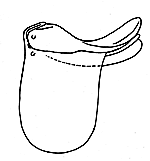
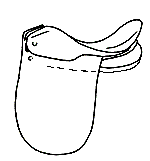
Left: Gusset Panel
Right: Traditional
Panel
Frequently riders become concerned whether the "banana"
shape of traditional panels provide an optimum amount of support for the
horse. It's certainly true that gusset panels have a greater surface area
than traditional panels and the question of support may indeed be an
important factor if the rider is a large, heavyweight person. But since the
majority of dressage riders are men and women of normal stature, this rarely
causes any problem for the horse and is certainly to be preferred to a heavy
weight being pressed into his loins.
Compare your horse's topline to the illustrations below - Thoroughbred
type on the left and Warmblood type on the right. If he is shaped like the
horse on the left, a gussetted panel is probably not a good choice.
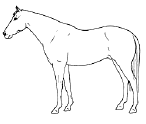
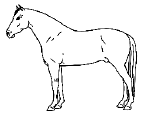
Figure 11
Left: TB type
Right: WB
type
Reflocking
When should my saddle be reflocked? The answer to that is
when and if it needs it! I have a 27 year old Passier that has never been
reflocked and doesn't need it yet! It has also never given a horse a
moment's discomfort in his back.
When your saddle requires reflocking, be sure to chose a
qualified craftsman for the job. A poorly reflocked panel will have lumps
that will cause uneven pressure and discomfort for your horse.
Saddle Care
Frequent oiling is not necessary to insure good service from
your saddle. As a matter of fact, precisely the opposite is true. Americans
tend to over oil their tack while in Europe oil is used very infrequently.
Regular cleaning with a quality glycerin soap will maintain your saddle in
top condition - keeping the leather supple yet sturdy. If the leather in
your saddle begins to feel dry or stiff from use or neglect, use a quality
leather oil product sparingly.
Exceptions
There are always exceptions and I try not to say "always" or
"never," for when I do I'm sure to immediately meet a horse or rider who
gives the lie to every rule. However, if you follow these guidelines and use
good common sense, as well as observing the way your horse reacts to a new
saddle, you'll probably not stray far in your efforts to find a fit for both
you and your horse. Good luck!
If you have additional saddle-fit questions, please feel free to call us
at 800/456-8225. We'll be happy to discuss your particular situation. Or
email your questions to connie@tackinthebox.com and I will
be happy to answer them.
Connie Micheletti
© 1997 Tack In The
Box

This brochure is compliments of Tack In The
Box.

© 2000 - 2010 Show Horse Promotions
All Rights Reserved
Privacy Statement

The Show Horse Promotions web site is an informational web site, this information is subject to change without notice. Any use of, or actions taken based upon any of the information contained on this web site is done entirely at your own risk.
Show Horse Promotions expressly prohibit you from republishing or redistributing this content without first receiving
our written consent. By using this site, you agree not to hold us liable for
any errors or delays in this content, or for any actions that you take in reliance thereon. This site contains links
to other Internet sites. These links are not endorsements by us of any products or services in those sites, and we have not
endorsed or approved any information in those
sites.
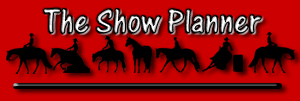

 Any
saddle must meet one very basic criteria in order to function as a useful
tool for riding: it must be correctly balanced. This is especially true of
the dressage saddle, owing to the refinement of weight and leg aids. This
first drawing is an illustration we're all familiar with. In order to allow
the rider to sit in a balanced position; with half of the upper body mass on
either side of the vertical line bisecting shoulder, hip and heel; the
stirrup bar of the saddle must be correctly placed. The stirrup leathers
should hang vertically and approximately 6" or 7" forward of the deepest
part of the seat. This corresponds roughly to the measurement from the ball
of the foot to the heel. The relationship of these two measurements is
obvious. If the deepest part of the saddle falls more than about 7" back
from the stirrup bar, the rider is encouraged to carry his leg too far
forward and automatically adopts the chair seat. Conversely, a stirrup bar
placed too far rearward causes the rider to sit on the crotch. We'll talk
more about balance when we discuss fitting the horse.
Any
saddle must meet one very basic criteria in order to function as a useful
tool for riding: it must be correctly balanced. This is especially true of
the dressage saddle, owing to the refinement of weight and leg aids. This
first drawing is an illustration we're all familiar with. In order to allow
the rider to sit in a balanced position; with half of the upper body mass on
either side of the vertical line bisecting shoulder, hip and heel; the
stirrup bar of the saddle must be correctly placed. The stirrup leathers
should hang vertically and approximately 6" or 7" forward of the deepest
part of the seat. This corresponds roughly to the measurement from the ball
of the foot to the heel. The relationship of these two measurements is
obvious. If the deepest part of the saddle falls more than about 7" back
from the stirrup bar, the rider is encouraged to carry his leg too far
forward and automatically adopts the chair seat. Conversely, a stirrup bar
placed too far rearward causes the rider to sit on the crotch. We'll talk
more about balance when we discuss fitting the horse. 


 The shafts of the two femurs are separated by the
diameter of the pelvis and the shafts slope downward and inward to bring the
knee joints near the line of gravity of the body. Owing to the female
pelvis' being shallower and wider than that of men, this inward slope tends
to be greater in women (left illustration) than it is in men (right
illustration) though there is considerable variation between individuals.
The more knock-kneed an individual is the more the inner thigh muscle tends
to be relatively round. The more nearly perpendicular the shafts of the
pelvis hang, the flatter the inner thigh muscle (the reason that most men
have much flatter inner thigh muscles than women and thus much less
difficulty getting the thigh to lie flat against the saddle).
The shafts of the two femurs are separated by the
diameter of the pelvis and the shafts slope downward and inward to bring the
knee joints near the line of gravity of the body. Owing to the female
pelvis' being shallower and wider than that of men, this inward slope tends
to be greater in women (left illustration) than it is in men (right
illustration) though there is considerable variation between individuals.
The more knock-kneed an individual is the more the inner thigh muscle tends
to be relatively round. The more nearly perpendicular the shafts of the
pelvis hang, the flatter the inner thigh muscle (the reason that most men
have much flatter inner thigh muscles than women and thus much less
difficulty getting the thigh to lie flat against the saddle). 

 in your mind, stand to the side of your horse and draw an imaginary line
through the center of the stirrup bar, perpendicular to the ground. Draw a
second imaginary line through the deepest part of the seat, again
perpendicular to the ground. As mentioned before, the deepest part of the
seat should be approximately 6-7" back from the center of the stirrup bar.
in your mind, stand to the side of your horse and draw an imaginary line
through the center of the stirrup bar, perpendicular to the ground. Draw a
second imaginary line through the deepest part of the seat, again
perpendicular to the ground. As mentioned before, the deepest part of the
seat should be approximately 6-7" back from the center of the stirrup bar.
 The illustration at left shows a saddle that is too narrow for
the horse and consequently sits with the deepest part of the seat too far
back from the stirrup bar. The last illustration of this series shows a
saddle that is too wide and has the deepest part of the seat too close to
the stirrup bar. The former will place your legs too far to the front while
the latter will tend to tip you onto your crotch.
The illustration at left shows a saddle that is too narrow for
the horse and consequently sits with the deepest part of the seat too far
back from the stirrup bar. The last illustration of this series shows a
saddle that is too wide and has the deepest part of the seat too close to
the stirrup bar. The former will place your legs too far to the front while
the latter will tend to tip you onto your crotch.



